| Anatomy of Flowering Plants Refresher Course |
| Anatomy of Flowering Plants Concepts Files |
| Anatomy of Flowering Plants Master Files |
| Anatomy of Flowering Plants Notes 1 |
| Anatomy of Flowering Plants Note 2 |
| Anatomy of Flowering Plants Note 3 |
Anatomy of Flowering Plants
Table of Content
- Define Tissue
- Meristematic Tissue
- Permanent Tissue
- Complex Tissues
- The Epidermal Tissue System
- The Ground Tissue System
- The Tissue system
- Vascular Tissue System
Study of internal structure of an organism is known as anatomy. Plant anatomy includes structure of tissues and organization.
Define Tissue
Group of cells that work together to perform specific function is known as Tissue. There are two main types of tissue found in plants- meristematic tissue and permanent tissue.
Meristematic Tissue
Undifferentiated group of cells capable of formation of new cells is known as Meristematic Tissue. It is a zone of actively dividing tissues.
Three types of meristem are found in plants:
1. Apical Meristem is located at the tips of the roots and shoots. It is involved in the elongation of roots and shoots. It is further divided into:
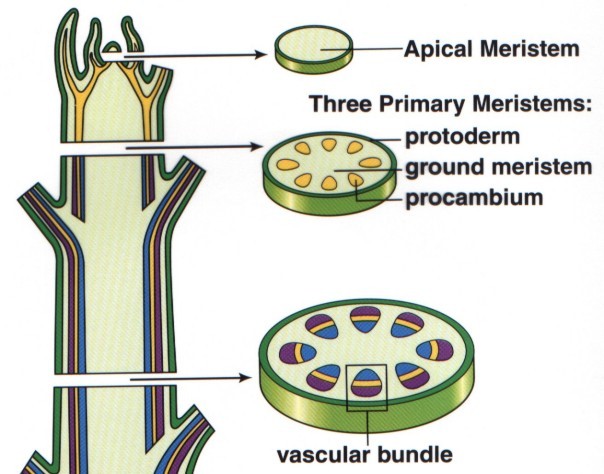
Fig. 1. Apical Meristem
- Problem that forms dermal tissues such as epidermis.
- Ground Meristem that forms cortical cells.
- Procambium that forms vascular tissue such as xylem and phloem.
2. Lateral Meristem participates in horizontal expansion of plant cells. It is divided into:
- Vascular Cambium involved the growth of secondary tissues such as xylem and phloem.
- Cork Cambium forms outer cork layer and inner layer of cells containing chlorophyll.
3. Intercalary Meristem is found only in monocots at the base of nodes and leaf blades. It helps in the regeneration of removal parts.
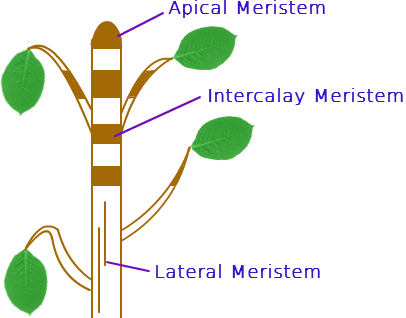
Fig. 2. Types of Meristem
Permanent Tissues
Cells of permanent tissues have lost the ability to divide. They are divided into simple and permanent and complex permanent tissues.
Simple permanent tissues are as follows:
1. Parenchyma
- It fills the soft part of the plants.
- They are living cells with cell wall made up of cellulose.
- They possess large vacuole that regulates the movement of water and minerals.
- Mesophyll cells in leaves are made up of parenchyma which helps in photosynthesis. Parenchyma cells with chloroplast are known as chlorenchyma.
- Parenchyma cells that provides buoyancy to aquatic plants are known as Aerenchyma.
2. Collenchyma
- These cells are elongated in structure with thick cell wall.
- They provide structural support to leaves and shoots.
- They are living cell which are closely packed.

Fig. 3. Types of simple permanent tissue
- Cell wall made up of cellulose and pectin.
3. Sclerenchyma
- They are supporting tissues in plants. They are found in regions of new growth.
- They are generally of two types- sclereids and fibres.
- Cell wall is made up of cellulose, hemicellulose, and lignin.
- They are made up of dead cells with thick cell walls.
- Fibres are also known as bast are long, slender cells.
- The most common example of fibres are grasses and agaves.
- Fibres are formed from meristematic tissue.
- Reduced form of sclerenchyma is known as sclereids.
Complex Tissues
Complex tissues are made of different types of cell elements. Xylem and phloem are complex tissues which together form the vascular bundle.
Xylem
It is a complex tissue that helps in conduction of water and minerals from the soil to the upper part of the plants. It consists of tracheid, vessels, xylem parenchyma and xylem fibres.
Tracheid
It is an elongated cell that is devoid of protoplast. So, tracheid is dead at maturity. Tracheid wall is usually thick and lignified. They have bordered pits. They occur both in primary and secondary xylem. They also have mechanical function.
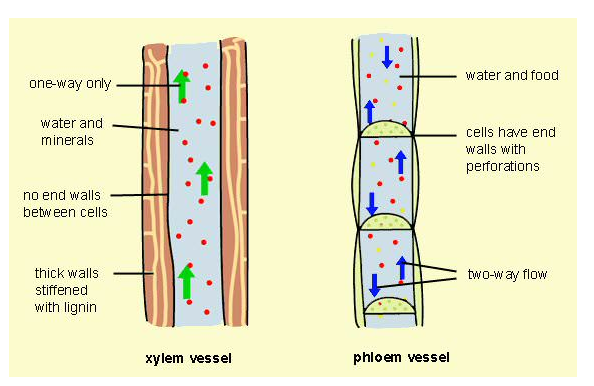
Fig. 4. Types of complex tissue
Xylem Fibres
They are supporting in function. They are elongated dead cells with lignified walls. They have bordered pits which are not well developed.
Xylem Vessels
They are cylindrical tube like structure placed end to end. They are also dead at maturity. Vessels are characteristic feature found in angiosperm. They are not found in gymnosperms.
Xylem Parenchyma
They are made up of parenchymatous cells which are thin walled and living.
Phloem
Also, known as Bast is a conducting tissue. It helps in the transport of solute from leaves to different parts of the plant. It is composed of sieve tubes, companion cells, phloem parenchyma and phloem fibres.
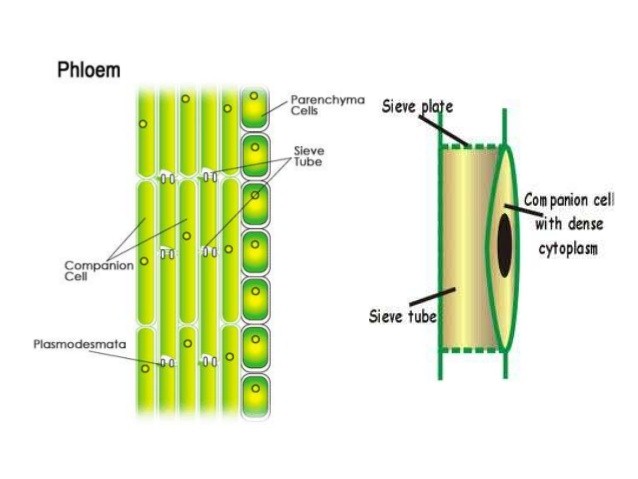
Fig. 5. Phloem
Sieve Tubes
They are the thin elongated cells which are placed end to end. They have perforated end walls known as sieve plates. Cytoplasm of one sieve element is continuous with those of the sieve elements above and below by cytoplasmic connections passing through the pores of the sieve plate.
Companion Cells
They are the characteristics of angiosperms. They have dense cytoplasm with elongated, large nucleus. In gymnosperms, instead of companion cells Albuminous cells are found.
Phloem Parenchyma
They are living parenchymatous cells. They are not found in monocot stems.
Phloem Fibres
They are long, narrow supportive cells that are mechanical in function.
The Tissue System
There are 3 types of tissue system found in plants:
- Epidermal Tissue System: It includes epidermis, cuticle, epidermal hairs, root hairs, trichomes and stomata.
- The ground Tissue System: It is divided into hypodermis, cortex, endodermis, pericycle, medullary rays and pith.
- The vascular Tissue System: It includes vascular bundles made up of xylem and phloem.
The Epidermal Tissue System
Epidermis is the outermost single layer of cells found in plants. It serves many function such as prevents water loss, gaseous exchange, secretion of metabolic compounds etc.
Cuticle is a film that covers the epidermis. It is a waxy layer that prevents excess loss of water.
Trichomes are epidermal outgrowths of plants. They act as defense system against the insects.
Roots hairs are the hairy outgrowth from the roots of the plants that helps in absorption of water and minerals from the soil.
The Ground Tissue System
It is divided into following parts:
Hypodermis lies below the epidermis. Cells of the hypodermis is parenchymatous as well as sclerenchymatous.
Cortex
Cells of the cortex is parenchymatous in nature. Cortex can be with or without chloroplast. They store carbohydrate and other substances such as resin, oils etc.
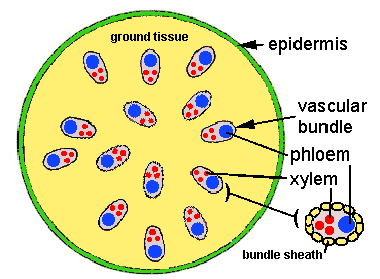
Fig. 6. Ground tissue system
Endodermis
Below the cortex lies the endodermis which has a thickening of casparian strips. These casparian strips contains deposition of suberin.
Pericycle
Between the endodermis and vascular bundle lies the pericycle. The cells can be parenchymatous or sclerenchymatous.
Pith
The center part of the root or stem is known as pith. The cells are parenchymatous in nature. In dicot stem and monocot root pith is well developed whereas in dicot root and monocot stem pith is reduced or absent.
Vascular Tissue System
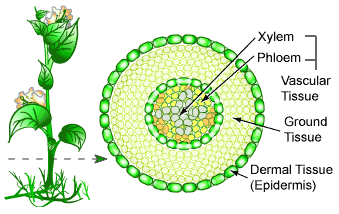
Fig. 7. Vascular tissue system
The different types of vascular bundles are as follows:
- Radial Bundles: When Xylem and phloem are located on alternate radii. For Example, in roots.
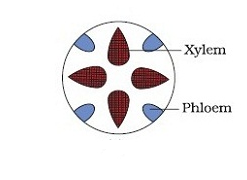
Fig. 8. Radial vascular bundles
- Conjoint Bundles: When xylem lies towards the center and phloem lies towards the periphery. Such bundles are known as Conjoint Bundles.
- Concentric Bundles: When one type of vascular bundle surrounds one type of vascular bundle. These are of two types – Amphivasal and Amphicribral.
Amphivasal
When xylem surrounds the phloem, For Example, Dracaena.
Amphicribral
When phloem surrounds the xylem, For Example, in Ferns.
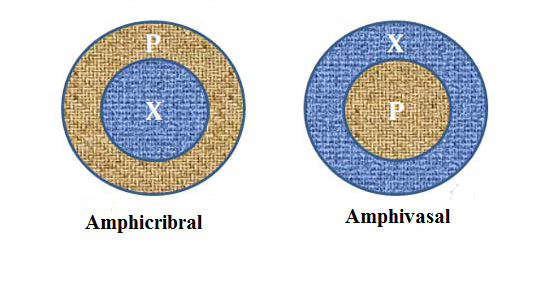
Fig. 9. Types of concentric bundles